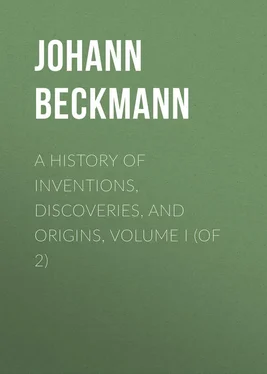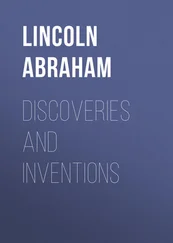Johann Beckmann - A History of Inventions, Discoveries, and Origins, Volume I (of 2)
Здесь есть возможность читать онлайн «Johann Beckmann - A History of Inventions, Discoveries, and Origins, Volume I (of 2)» — ознакомительный отрывок электронной книги совершенно бесплатно, а после прочтения отрывка купить полную версию. В некоторых случаях можно слушать аудио, скачать через торрент в формате fb2 и присутствует краткое содержание. Жанр: foreign_antique, foreign_prose, на английском языке. Описание произведения, (предисловие) а так же отзывы посетителей доступны на портале библиотеки ЛибКат.
- Название:A History of Inventions, Discoveries, and Origins, Volume I (of 2)
- Автор:
- Жанр:
- Год:неизвестен
- ISBN:нет данных
- Рейтинг книги:4 / 5. Голосов: 1
-
Избранное:Добавить в избранное
- Отзывы:
-
Ваша оценка:
- 80
- 1
- 2
- 3
- 4
- 5
A History of Inventions, Discoveries, and Origins, Volume I (of 2): краткое содержание, описание и аннотация
Предлагаем к чтению аннотацию, описание, краткое содержание или предисловие (зависит от того, что написал сам автор книги «A History of Inventions, Discoveries, and Origins, Volume I (of 2)»). Если вы не нашли необходимую информацию о книге — напишите в комментариях, мы постараемся отыскать её.
A History of Inventions, Discoveries, and Origins, Volume I (of 2) — читать онлайн ознакомительный отрывок
Ниже представлен текст книги, разбитый по страницам. Система сохранения места последней прочитанной страницы, позволяет с удобством читать онлайн бесплатно книгу «A History of Inventions, Discoveries, and Origins, Volume I (of 2)», без необходимости каждый раз заново искать на чём Вы остановились. Поставьте закладку, и сможете в любой момент перейти на страницу, на которой закончили чтение.
Интервал:
Закладка:
In the end of this work Stevin endeavours to show that the Romans, or rather the Grecians (for the former knew scarcely anything but what the latter had discovered), were in some measure acquainted with book-keeping, and supports his conjecture by quoting Cicero’s oration for Roscius. I confess that the following passage in Pliny, Fortunæ omnia expensa, huic omnia feruntur accepta, et in tota ratione mortalium sola utramque paginam facit 14, as well as the terms tabulæ accepti et expensi ; nomina translata in tabulas , seem to indicate that the Romans entered debit and credit in their books on two different pages; but it appears to me not yet proved, and improbable, that they were acquainted with our scientific method of book-keeping; with the mode of opening various accounts; of comparing them together, and of bringing them to a final balance. As bills of exchange and insurance were not known in the commerce of the ancients, the business of merchants was not so intricate and complex as to require such a variety of books and accounts as is necessary in that of the moderns.
Klipstein is of opinion that attempts were made in France to apply book-keeping, by double-entry, to the public accounts, under Henry IV., afterwards under Colbert, and again in the year 1716. That attempts were made, for this purpose, under Henry IV., he concludes from a work entitled An Inquiry into the Finances of France; but I do not know whether what the author says be sufficient to support this opinion.
[The system of double-entry began from the commencement of the present century to be adopted by several governments in the management of the public accounts, among others by those of Austria, France and Holland, with highly beneficial effects. Some attempts have been more recently made in this country to introduce it into the government offices, and from the great success which has attended them, this system will probably soon be generally used.]
ODOMETER
An Odometer, Pedometer, Perambulator, or Way-measurer, is an instrument or machine by which the steps of a person who walks, or the revolutions made by the wheel of a carriage, can be counted, and by which the distance that one has travelled can be ascertained. Vitruvius, in his tenth book 15, describes a machine of this kind for a carriage, and which, in his opinion, would answer for a ship. We are told by Capitolinus, in the life of the emperor Pertinax, that among the effects of the emperor Commodus exposed to sale, there were carriages of various kinds, some of which “measured the road, and pointed out the hours;” but whether by these words we are to understand an odometer, cannot with certainty be determined.
That this instrument was known even in the fifteenth century, can be proved from the carving on the ducal palace at Urbino – an edifice erected in an uncommon style of magnificence, by duke Frederic, who died in 1482. The ornaments here employed form, almost, a complete representation of all the warlike apparatus used at that period, both by sea and land; and among these is the figure of a ship, which seems to be furnished with an odometer; but whether the wheels and springs, carved out apart, be intended to show the construction of it, I will not venture to decide 16.
The celebrated John Fernel, physician to Catherine of Medici, queen of France, measured with an instrument of this kind, in 1550, a degree of the meridian between Paris and Amiens, and found it to be 68,096 geometrical paces, or about 56,747 toises (364,960 English feet); that is, 303 toises less than Picard found it to be; or about 300 toises less than later measurements have made it. Picard himself, in his mathematical measurement, assisted by the newest improvements, erred 123 toises. It is therefore very surprising that Fernel should approach so near the truth with such an instrument. The manner of constructing it however, as far as I know, appears to be lost 17.
Levin Hulsius, in his Treatise of mechanical instruments, published at Frankfort in 1604, describes an odometer, but without naming the inventor. It appears, however, that it was the production of Paul Pfinzing, born at Nuremberg in 1554 18; and who, besides other works, published, in 1598, Methodus Geometrica, or a Treatise on measuring land, and how to use proper instruments for that purpose, on foot, on horseback, or in a carriage. This treatise, which was never sold, but given away by the author, contains a description of the same instrument described by Hulsius, and which, as Nicolai says, is still preserved in the collection of curiosities at Dresden.
In the same collection is an odometer which Augustus, elector of Saxony, who reigned between the years 1553 and 1586, employed in measuring his territories. This instrument is mentioned by Beutel 19, without naming the inventor; but I think it very probable that it was made by Martin Feyhel, who was born at Naumburg, and resided at Augsburg; as Von Stetten 20relates, in his History of the Arts at Augsburg, that Feyhel made a way-measurer (probably odometer) for the elector of Saxony, and that he himself called it a new instrument never before heard of. This artist was an intimate friend of the celebrated Christopher Schissler, also of Augsburg, who in 1579 constructed a quadrant, still to be found at Oxford; and in 1606 an armillary sphere, still preserved at Augsburg.
The emperor Rudolphus II., who reigned from 1576 to 1612, and who was fond of, and acquainted with, the mechanical arts, possessed two very curious odometers, which not only pointed out distances, but also marked them down on paper by the way. The description and use of one of these is given by De Boot 21, who was that prince’s librarian; and what he says has been copied by Kircher 22, and illustrated with a coarse figure. It is not improbable that the before-mentioned Schissler was the maker of this instrument, as we are informed by Stetten that he constructed a great many machines and automata for the emperor Rudolphus II. The other odometer, which was much more curious, appears to have been constructed by that emperor himself 23.
About the end of the 17th century, an artist in England, named Butterfield, invented an odometer which met with great approbation. In the first volume of the Philosophical Transactions there are two papers written by this ingenious man; but of his odometer I have not yet been able to find a description.
In the beginning of the last century, Adam Frederick Zurner, to whom we are indebted for good maps of the electorate of Saxony, invented also an odometer, or geometrical carriage, a description and figure of which, taken from Schramm’s Saxonia Monumentis Viarum illustrata, is given by Nicolai. This instrument is not now to be found in the Dresden collection.
In Bion’s Treatise on the construction of mathematical instruments, improved by Doppelmayer, there is a description of a pedometer, and the author praises a new invention by one Sauveur.
In the year 1724 Meynier laid before the Royal Academy of Sciences at Paris an odometer, a short account of which, without a figure, is given in the history of the Academy for that year. This machine was afterwards improved by Outhier; and a description of the improvements, but without any figure, is to be found in the history of the Academy for 1742. A full description, together with a figure, may however be seen in a work, entitled Machines et Inventions approuvées par l’Académie, t. vii.
Perhaps the most perfect machine of this kind was that made at Berlin by an artist named Hohlfeld, a short account of which may be found in the ninth volume of the Hamburg Magazine. A complete description I have not seen; but I learn from Professor Bernoulli’s Tour through Brandenburg, Pomerania, &c., that a model of it is preserved in the excellent collection of Count de Podewils at Gusow 24. The inventor of it was a man of such rare talents, and rendered such benefit to the public, that the following anecdotes of his life may prove not unacceptable to many readers. It was written by Professor Muller at Berlin, and transmitted to me by Dr. Bloch.
Читать дальшеИнтервал:
Закладка:
Похожие книги на «A History of Inventions, Discoveries, and Origins, Volume I (of 2)»
Представляем Вашему вниманию похожие книги на «A History of Inventions, Discoveries, and Origins, Volume I (of 2)» списком для выбора. Мы отобрали схожую по названию и смыслу литературу в надежде предоставить читателям больше вариантов отыскать новые, интересные, ещё непрочитанные произведения.
Обсуждение, отзывы о книге «A History of Inventions, Discoveries, and Origins, Volume I (of 2)» и просто собственные мнения читателей. Оставьте ваши комментарии, напишите, что Вы думаете о произведении, его смысле или главных героях. Укажите что конкретно понравилось, а что нет, и почему Вы так считаете.












